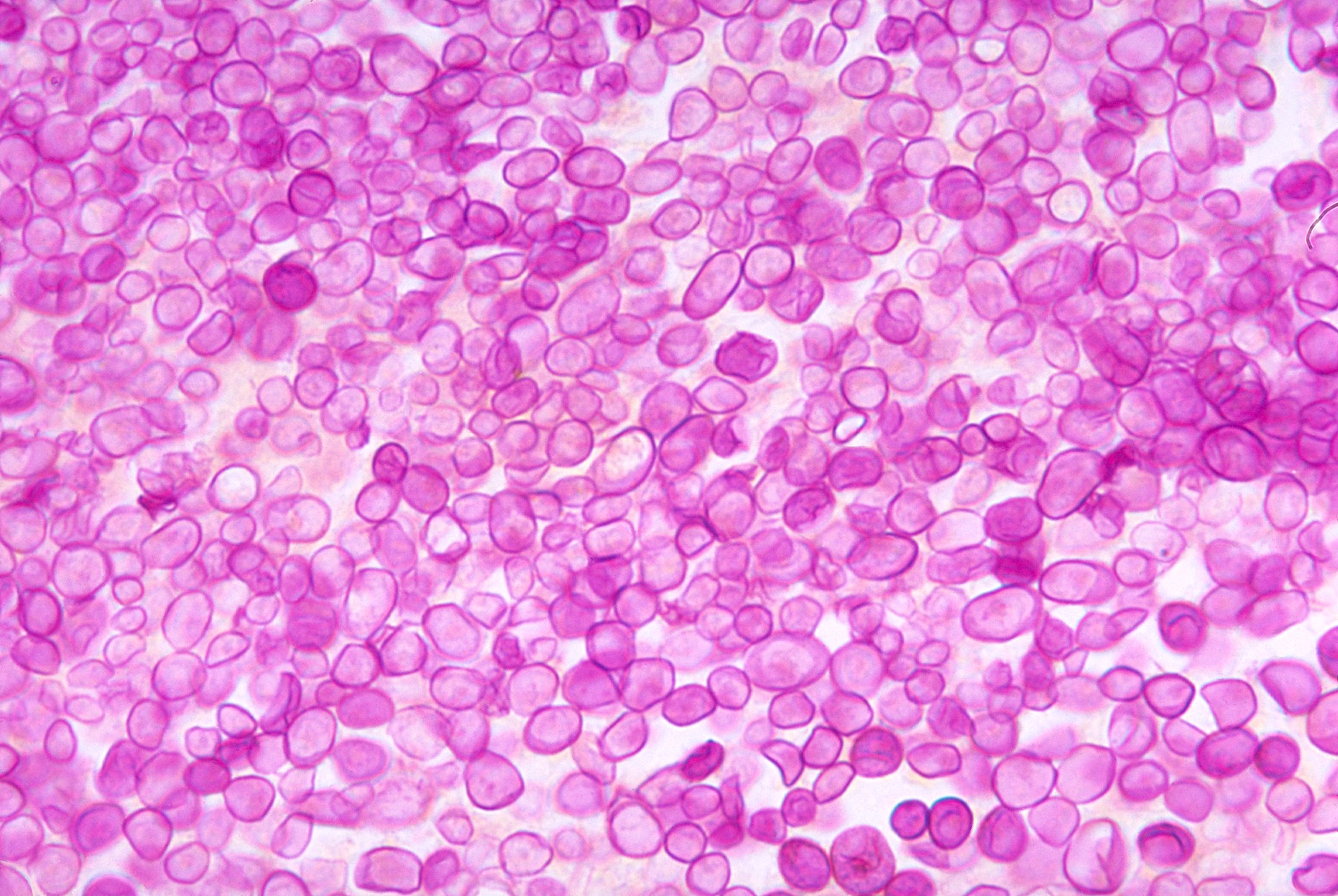- Protothecosis
Infobox_Disease
Name = Protothecosis

Caption = Histologic stain of a "Prototheca zopfii" infection in a dog
DiseasesDB =
ICD10 = ICD10|B|88|8|b|85 (ILDS B88.83)
ICD9 =
ICDO =
OMIM =
MedlinePlus =
eMedicineSubj = derm
eMedicineTopic = 348
MeshID =Protothecosis is a disease found in
dog s,cat s,cattle , and humans caused by a type ofgreen algae known as "Prototheca " that lackschlorophyll . It is the only known infectiouspathogen that is also a plant.cite journal |author=Roesler U, Hensel A |title=Longitudinal analysis of Prototheca zopfii-specific immune responses: correlation with disease progression and carriage in dairy cows |journal=J Clin Microbiol |volume=41 |issue=3 |pages=1181–6 |year=2003 |pmid=12624049 |doi=10.1128/JCM.41.3.1181-1186.2003] The two most common species are "Prototheca wickerhami " and "Prototheca zopfii ". Both are known to cause disease in dogs, while most human cases are caused by "P. wickerhami".cite journal |author=Leimann B, Monteiro P, Lazéra M, Candanoza E, Wanke B |title=Protothecosis |journal=Med Mycol |volume=42 |issue=2 |pages=95–106 |year=2004 |pmid=15124862 |doi=10.1080/13695780310001653653] "Prototheca" is found worldwide insewage andsoil . Infection is rare despite high exposure, and can be related to a defectiveimmune system .cite journal |author=Hosaka S, Hosaka M |title=A case report of canine protothecosis |journal=J Vet Med Sci |volume=66 |issue=5 |pages=593–7 |year=2004 |pmid=15187378 |doi=10.1292/jvms.66.593] In dogs, females andCollie s are most commonly affected.cite book|author=Ettinger, Stephen J.;Feldman, Edward C.|title=Textbook of Veterinary Internal Medicine|edition=4th ed.|publisher=W.B. Saunders Company|year=1995|id=ISBN 0-7216-6795-3] The first human case was identified in 1964 inSierra Leone . [cite journal |author=Lass-Flörl C, Fille M, Gunsilius E, Gastl G, Nachbaur D |title=Disseminated infection with Prototheca zopfii after unrelated stem cell transplantation for leukemia |journal=J. Clin. Microbiol. |volume=42 |issue=10 |pages=4907–8 |year=2004 |pmid=15472379 |doi=10.1128/JCM.42.10.4907-4908.2004]The organism
"Prototheca" has been thought to be a mutant of "
Chlorella ", a type of single-celled green algae. However, while "Chlorella" containsgalactose andgalactosamine in the cell wall, "Prototheca" lacks these. Also, "Chlorella" obtains its energy throughphotosynthesis , while "Prototheca" issaprotroph ic, feeding on dead and decaying organic matter. When "Prototheca" was first isolated fromslime flux of trees in 1894, it was thought to be a type offungus .cite journal |author=Hollingsworth S |title=Canine protothecosis |journal=Vet Clin North Am Small Anim Pract |volume=30 |issue=5 |pages=1091–101 |year=2000 |pmid=11033876] Its size varies from 2 to 15micrometre s. [cite journal |author=Lee W, Lagios M, Leonards R |title=Wound infection by Prototheca wickerhamii, a saprophytic alga pathogenic for man |journal=J Clin Microbiol |volume=2 |issue=1 |pages=62–6 |year=1975 |pmid=1225929]Cutaneous protothecosis
The two main forms of protothecosis are cutaneous and disseminated. Cats are exclusively infected with the cutaneous, or skin, form.cite web|author=Vite, C.H.|year=2005|title=Inflammatory Diseases of the Central Nervous System |work=Braund's Clinical Neurology in Small Animals: Localization, Diagnosis and Treatment| url=http://www.ivis.org/advances/vite/braund27/chapter_frm.asp?LA=1#Protothecosis|accessdate=2006-08-22] Symptoms include soft lumps on the skin of the ears, legs, feet, nose, and head. Infection usually occurs through a wound in the skin. Humans are also usually affected by the cutaneous form, but immunocompromised individuals may develop disseminated protothecosis. [cite journal |author=Thiele D, Bergmann A |title=Protothecosis in human medicine |journal=International journal of hygiene and environmental health |volume=204 |issue=5-6 |pages=297–302 |year=2002 |pmid=11885351 |doi=10.1078/1438-4639-00105]
Surgery is the treatment of choice for the cutaneous form.Prothecosis in cattle
Cattle can be affected by protothecal
enteritis andmastitis .cite journal |author=Osterstock J, Mansell J, Roussel A |title=Protothecal enteritis as a cause of protein-losing enteropathy in a bull |journal=J Am Vet Med Assoc |volume=227 |issue=9 |pages=1476–9, 1418 |year=2005 |pmid=16279394 |doi=10.2460/javma.2005.227.1476] Protothecal mastitis is endemic worldwide, although most cases of infected herds have been reported inGermany , theUnited States , andBrazil .Protothecosis in dogs
Disseminated protothecosis is most commonly seen in dogs. The algae enters the body through the mouth or nose and causes infection in the intestines. From there it can spread to the eye, brain, and kidneys. Symptoms can include
diarrhea , weight loss, weakness, inflammation of the eye (uveitis ),retinal detachment ,ataxia , andseizure s. [cite journal | last = Gionfriddo | first = Juliet R. | title = An unusual cause of blindness in a Siberian husky | journal = Veterinary Medicine | volume = 102 | issue = 3 | pages = 172–178 | publisher = Advanstar Communications | month = March | year = 2007 ]Dogs with acute blindness and diarrhea that develop exudative
retinal detachment should be assessed for protothecosis. Diagnosis is through culture or finding the organism in abiopsy ,cerebrospinal fluid ,vitreous humour , or urine. Treatment of the disseminated form in dogs is very difficult, although use of antifungal medication has been successful in a few cases.Prognosis for cutaneous protothecosis is guarded and depends on the surgical options. Prognosis for the disseminated form is grave. This may be due to delayed recognition and treatment.References
Wikimedia Foundation. 2010.
